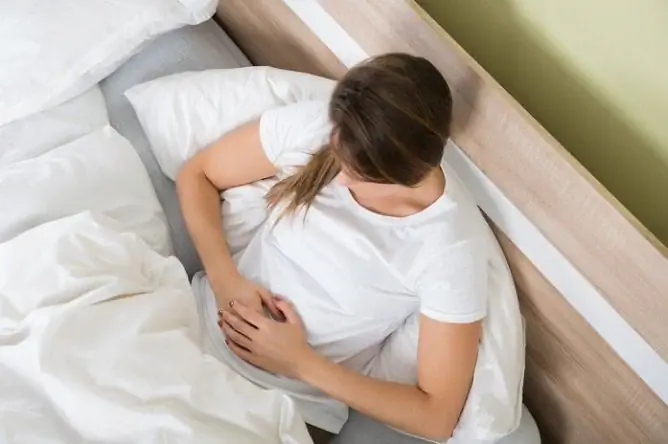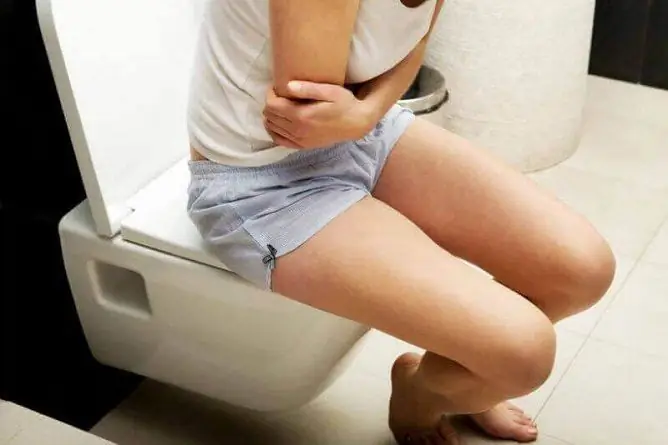- Author Rachel Wainwright [email protected].
- Public 2024-01-15 19:51.
- Last modified 2025-11-02 20:14.
Chronic constipation
The content of the article:
- The causes of chronic constipation
- Classification
- Symptoms
- Complications
- Diagnostics
-
Chronic constipation treatment
- Diet therapy
- Drug therapy
- Other methods
- It is important to know
- Prevention
- Video
Chronic constipation is a long-term dysfunction of the intestines, in which the intervals between bowel movements are increased and can be more than 3-5 days. This pathological condition can be a clinical manifestation of a disease, or it can indicate that a person is leading an incorrect lifestyle.
According to statistics, in developed countries, constipation is recorded in 30-50% of the adult population and in 5-20% of children. In elderly patients, pathology is observed more often (about 5 times) than in young people.

Chronic constipation leads to a general deterioration in health
The causes of chronic constipation
Constipation is one of the most common pathologies of the gastrointestinal tract (GIT). Often the chronic form of pathology is observed in women during pregnancy.
Constipation can be caused by:
- dyskinesia of the large intestine;
- dyschezia (violation of the act of defecation);
- violation of the coordination of intestinal contractions (pathology of nervous genesis);
- decreased sensitivity of the nerve endings of the rectum;
- a sedentary lifestyle, including long-term adherence to bed rest;
- frequent delay in bowel movement when there is a urge to defecate;
- intestinal anomalies;
- spinal cord injury;
- portal hypertension;
- heart failure;
- overweight;
- insufficient night sleep;
- disorders of the endocrine and / or nervous system;
- the use of certain medicines;
- exposure to the body of chemicals;
- damage to the musculature of the intestine and / or sphincter.
In children of the first year of life, the main reasons for the development of pathology include abnormalities in the development of the intestines, food allergies, and poor nutrition. For a child over 1 year old, reasons may include potty training too early, long travel, or lack of sanitation in the preschool or school.
Rarely enough, in older children, the disease develops against the background of anal fissure, paraproctitis, hemorrhoids. In childhood, psychogenic constipation is often observed. The highest risk of pathology occurs when switching to solid food, potty training, and also at the beginning of school.
Classification
Pathology is divided into 2 groups, which are presented in the table.
| Constipation type | Description |
| Functional | The defecation reflex (rectal) weakens or disappears, there is a slowdown in the passage of feces through the intestines (cologenic), impaired intestinal motor function (dyskinetic) |
| Organic | Damage to the intestinal structure is noted (with dysbiosis, hemorrhoids, cicatricial changes, colitis, rectal prolapse, etc.) |
Depending on the etymology:
| Constipation type | Characteristic |
| Primary | Congenital or acquired in the presence of anomalies in the development of the large intestine and disorders of its innervation. |
| Secondary | They develop against the background of diseases, injuries, with the use of certain drugs. |
| Idiopathic | The exact cause cannot be determined. |
Chronic constipation can also be:
- alimentary - occurs with an unbalanced diet, insufficient fluid intake;
- mechanical - develops in the presence of organic changes in the intestine.
Symptoms
There are some pathological conditions that are accepted by the patient for constipation, but they are not. Constipation is a matter of delaying bowel movements for more than 3 days, which may be accompanied by difficulties in emptying the intestines, the discharge of a small (up to 100 g) amount of feces of increased hardness. In patients with constipation, the transit time of food from the mouth to the anus can exceed 60 hours (in some cases even 120 hours).
When chronic constipation occurs against the background of weakening of the motility of the large intestine and its expansion, the bowel movements are usually abundant, the feces are formalized. During the act of defecation, a portion of denser feces (larger diameter than normal) first leaves, followed by faeces of a softer consistency (half-shaped feces). In some cases, unstable stools are observed, while constipation alternates with diarrhea. In some patients, feces resemble sheep feces (feces in the form of separate dense lumps). In case of violation of the integrity of the rectal mucosa during defecation, blood impurities can be found on the surface of the feces.
With the development of pathology against the background of a decrease in the tone of the large intestine, the urge to defecate in a person may be absent even if there is a feeling of intestinal overcrowding, nausea and flatulence.
Chronic constipation often occurs in conjunction with hemorrhoids. Hemorrhoids without delay in bowel movement are quite rare, and patients suffering from constipation often notice bleeding during the act of defecation, itching and / or pain in the anal area, and with long-term pathology - prolapse of hemorrhoids. In some cases, patients require manual removal of feces and reduction of the rectum after the act of defecation.
With the development of chronic constipation, patients are observed:
- flatulence;
- feeling of fullness;
- colicky abdominal pain;
- pain during bowel movements.
Also, patients may complain about:
- weakness and fatigue;
- decreased performance;
- flabbiness and unhealthy skin color;
- deterioration of hair, nails;
- bad breath;
- dyspnea;
- loss of appetite;
- heartburn;
- belching with air.
Complications
In patients with chronic constipation, in the absence of adequate treatment, inflammatory processes in the rectum and sigmoid colon, secondary colitis, enteritis, hemorrhoids, paraproctitis, acquired megacolon, etc. may occur.
Diagnostics
It is possible to determine functional constipation in a patient if the following signs (two or more of the listed ones) occur within 12 weeks a year:
- straining during bowel movement, which takes at least 1/4 of the total duration of the act of defecation;
- a feeling of incomplete emptying of the intestine at least with 1 out of 4 last acts of bowel movement;
- separation of solid and / or fragmented feces in at least 25% of consecutive bowel movements;
- reducing the number of acts of defecation to 3 in 1 week or less;
- a sense of an obstacle in the evacuation of feces at least 1 in 4 cases of bowel movement;
- the need to carry out manipulations that facilitate bowel movement, at least with 1 out of 4 consecutive acts of defecation.
When making a diagnosis, the presence or absence of loose stools in the patient is taken into account.
For a clarifying diagnosis, you may need:
- digital rectal examination;
- colonoscopy (to exclude neoplasms, colitis);
- assessment of the function of the muscles of the pelvic floor;
- determination of pressure in the rectum;
- X-ray examination with contrast agents;
- laboratory tests (general blood and urine analysis, biochemical blood test, coprogram, fecal occult blood test, dysbiosis test, etc.).
Chronic constipation treatment
Diet therapy
First of all, the patient is advised to follow the diet. In some cases, making changes to the menu is enough to cure the pathology.
The diet is usually prescribed to patients with delayed bowel movements of any etiology. Patients are recommended fractional meals (5 times a day). The interval between meals should not be large.
The patient should eat more ballast foods (plant foods, consisting of substances that are not completely digested in the digestive tract), as well as foods that stimulate intestinal motor activity.
The diet should include:
- vegetables (cucumbers, beets, zucchini, carrots);
- fruits (pears, plums, peaches, apricots, sweet apples, citrus fruits);
- berries (gooseberries, blueberries);
- dried fruits (prunes, dates, dried apricots);
- wholemeal bread;
- nuts;
- flax seeds;
- oatmeal, buckwheat, barley groats;
- dairy products;
- vegetable oils (corn, olive, sunflower, soy).

Foods high in dietary fiber can help relieve nutritional constipation
The daily volume of liquid drunk in the absence of contraindications should be at least 1.5 liters. Patients can drink herbal tea (peppermint, chamomile), juices (berry, fruit, vegetable), mineral water (especially hydrocarbonate-magnesium).
It is recommended to limit the consumption of semolina, rice, pasta, potatoes. You should not eat foods that contribute to the development of flatulence. Apple and grape juice is usually not recommended for this pathology.
It is recommended to exclude from the diet:
- high-grade flour bread, baked goods;
- canned food;
- fatty meats;
- smoked products;
- spicy dishes;
- chocolate;
- strong tea and coffee.
Drug therapy
For constipation, laxatives can be used, which are divided into several groups.
| Drugs | Act |
| Vegetable | They contribute to an increase in the volume of feces and their softening, contain hydrophilic fibers (Mucofalk). |
| Osmotic | They have an irritating effect on rectal receptors, slow down the absorption of water (Forlax). |
| Contact | They enhance mucus formation and improve intestinal motility (Bisacodyl). |
Depending on the cause of the development of the pathology, the patient may be prescribed drugs for dysbiosis, antispasmodics, etc.
Other methods
As a means of quick relief, enemas can be used (cannot be done constantly).
A good therapeutic effect is provided by:
- exercise therapy exercises;
- physiotherapy;
- massage and self-massage.
It is important to know
You should not try to cure chronic constipation on your own, as therapy depends on the cause. The uncontrolled use of medicines and traditional methods of treatment can lead to a worsening of the patient's condition.
It is not allowed to take laxatives when a violation of defecation is combined with bloating, pain in the abdomen, an increase in body temperature, the detection of an admixture of blood in the feces, a decrease in body weight, etc.
With the constant use of laxatives, addiction occurs with the patient's loss of independent urge to defecate.
Prevention
In order to prevent pathology (including preventing the transition of acute constipation to chronic), it is recommended:
- intake of a sufficient amount of fluid;
- proper nutrition;
- physical activity;
- regular walks in the fresh air;
- timely treatment of diseases; which can lead to the development of delayed bowel movements;
- avoiding prolonged sitting on the toilet.
To prevent the development of defecation disorders associated with the lack of urge, it is recommended to form the habit of using the toilet at about the same time.
Video
We offer for viewing a video on the topic of the article.

Anna Aksenova Medical journalist About the author
Education: 2004-2007 "First Kiev Medical College" specialty "Laboratory Diagnostics".
Found a mistake in the text? Select it and press Ctrl + Enter.






